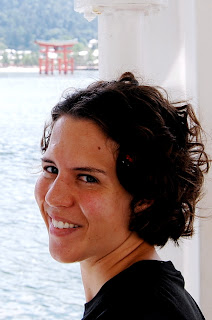 I'm thrilled to report that I read — and understood! — my first Japanese sign a few days ago. Hurray! I see this sign everyday on my walk to school. And finally, after weeks of drilling hiragana, I looked at this sign on my walk home and started sounding it out under my breath: "Ya-ki-ni-ku Ee." Excited, I blurted out the definition: "Broiled meat! Yes!" (Literally — ee means yes.) No doubt people on the street thought I was a wacky gaijin (foreigner), but I didn't care. Joe and I have been attending free Japanese classes twice a week at the Hiroshima International Center for a while now. And everyday for the past several weeks, I've been copying down Japanese words in romaji (the roman alphabet) from my dictionary and re-writing them in hiragana. Finally, all that work is starting to pay off! It's actually sticking!
I'm thrilled to report that I read — and understood! — my first Japanese sign a few days ago. Hurray! I see this sign everyday on my walk to school. And finally, after weeks of drilling hiragana, I looked at this sign on my walk home and started sounding it out under my breath: "Ya-ki-ni-ku Ee." Excited, I blurted out the definition: "Broiled meat! Yes!" (Literally — ee means yes.) No doubt people on the street thought I was a wacky gaijin (foreigner), but I didn't care. Joe and I have been attending free Japanese classes twice a week at the Hiroshima International Center for a while now. And everyday for the past several weeks, I've been copying down Japanese words in romaji (the roman alphabet) from my dictionary and re-writing them in hiragana. Finally, all that work is starting to pay off! It's actually sticking!The Japanese language is written using a combination of three sets of symbols. The first two, hiragana and katakana, are phonetic, meaning the symbols represent sounds, like the Roman alphabet. Hiragana is used to spell words of native Japanese origin. Katakana is used to spell foreign words.
Besides these two phonetic alphabets, the Japanese also use kanji, those really intricate symbols that might as well be hieroglyphics. They represent whole words or concepts. You need to know about 2,000 to read the newspaper. It'll be years before I know that many.
But in the meantime, I consider it a significant accomplishment that I've pretty much mastered hiragana. Any time I'm out for a walk now, I always look at signs and see what I can read. Most of the time I can only read portions of a sign since the hiragana are mixed together with the katakana and kanji. And often, even when I can sound out the parts printed in hiragana, I still don't know what the words actually mean. But sometimes I do, and it brings me joy. I am now starting to feel like I really will know some functional Japanese by the time we leave Japan.
It makes me really excited to keep learning. Today I looked up a website belonging to Bob Miller, my Japanese instructor from Sinclair Community College back home. All his lessons and worksheets from his introductory conversational Japanese 1 and 2 courses are online. I looked back at the lessons from the first course and realized I had all that material down pat. And now I can refer back to the lessons from the second course I took and start mastering all the different verb forms and tenses. Once I'm comfortable with verbs, I should be able to combine that knowledge with the vocabulary I've picked up so far to truly start communicating.
